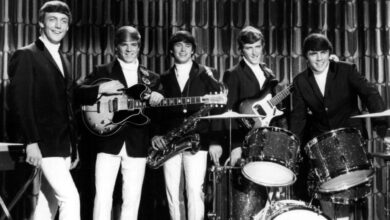“Danny And The Juniors’ ‘At The Hop’: The Iconic Rock ‘n’ Roll Anthem That Defined 1950s Dance Culture
In the vibrant era of the late 1950s, a group of Philadelphia teenagers captured the essence of youthful exuberance with a song that would become an anthem for a generation. Danny and the Juniors’ “At The Hop” not only dominated the charts but also encapsulated the spirit of rock ‘n’ roll dances, known as “hops,” that were the heartbeat of teenage social life.
The origins of Danny and the Juniors trace back to 1955 at John Bartram High School in Philadelphia. Four friends—Danny Rapp, Dave White, Frank Maffei, and Joe Terranova—formed a vocal group initially named The Juvenaires. Influenced by doo-wop and the burgeoning rock ‘n’ roll scene, they honed their harmonies at school events and local gatherings, gradually building a reputation in their community.
Their journey took a pivotal turn when they met local record producer John Madara, who introduced them to DJs Larry Brown and Artie Singer of Singular Records. Recognizing the group’s potential, Singer and Madara collaborated with White to craft a song titled “Do the Bop,” aiming to capitalize on the popular dance craze of the time.
However, fate intervened when influential DJ Dick Clark suggested that the term “bop” was becoming outdated. He proposed renaming the song to “At The Hop” and the group to Danny and the Juniors, reflecting a more contemporary appeal. Embracing this advice, the group re-recorded the track with revised lyrics, shifting the focus from a specific dance to the broader concept of a “hop,” a term synonymous with teenage dance parties.
Released in the fall of 1957, “At The Hop” quickly gained traction. Its infectious energy and relatable lyrics resonated with the youth, leading to a memorable performance on Dick Clark’s “American Bandstand.” This national exposure catapulted the song to the top of the charts, where it secured the number one spot on the Billboard pop and R&B charts in January 1958, maintaining its reign for five consecutive weeks.
The song’s success was not confined to the United States. Internationally, “At The Hop” achieved significant acclaim, reaching number three on the UK charts and enjoying a three-week tenure at number one in Canada. Its universal appeal lay in its celebration of the dance culture that was sweeping across continents, making it a global anthem for the rock ‘n’ roll movement.
Musically, “At The Hop” is a masterful blend of the twelve-bar blues structure, boogie-woogie piano rhythms, and the quintessential ’50s chord progression. This combination created an upbeat, danceable track that perfectly mirrored the enthusiasm of the era. The lyrics vividly describe the dance scene, referencing popular moves like the stomp, the stroll, the chalypso, and the chicken, inviting listeners to join in the fun.
Following the monumental success of “At The Hop,” Danny and the Juniors released “Rock and Roll Is Here to Stay,” a defiant anthem asserting the permanence of the genre amidst skepticism from older generations. This track further cemented their place in rock ‘n’ roll history, reaching number 19 on the Billboard charts and becoming a staple in the genre’s repertoire.
Despite their early achievements, the group faced challenges in sustaining their initial momentum. Subsequent releases like “Dottie” and “Twistin’ USA” achieved moderate success but couldn’t replicate the impact of their earlier hits. As musical trends evolved, the group’s prominence waned, leading to lineup changes and shifts in their musical direction.
Tragically, lead vocalist Danny Rapp’s life ended prematurely in 1983, casting a shadow over the group’s legacy. However, the surviving members continued to honor their musical heritage, performing and keeping the spirit of their songs alive for nostalgic audiences.
The enduring appeal of “At The Hop” is evident in its continued presence in popular culture. The song experienced a resurgence after being performed by Sha Na Na at the 1969 Woodstock Festival and featured in the 1973 film “American Graffiti,” introducing it to new generations and reaffirming its status as a rock ‘n’ roll classic.
Reflecting on the song’s impact, it’s clear that “At The Hop” did more than top charts; it captured a cultural moment. It celebrated the communal joy of dance, the excitement of youth, and the transformative power of music. Its success opened doors for other young artists and underscored the significance of teenage culture in the music industry.
In the broader context of music history, Danny and the Juniors’ contribution with “At The Hop” serves as a testament to the timeless appeal of rock ‘n’ roll. The song’s infectious rhythm and spirited lyrics continue to inspire, reminding us of a time when music was a unifying force, bringing people together on dance floors and transcending generational divides.
Decades after its release, “At The Hop” remains a beloved classic, a symbol of the golden age of rock ‘n’ roll. Its legacy endures, echoing the sentiments of a generation that danced its way into history, leaving an indelible mark on the cultural landscape.



